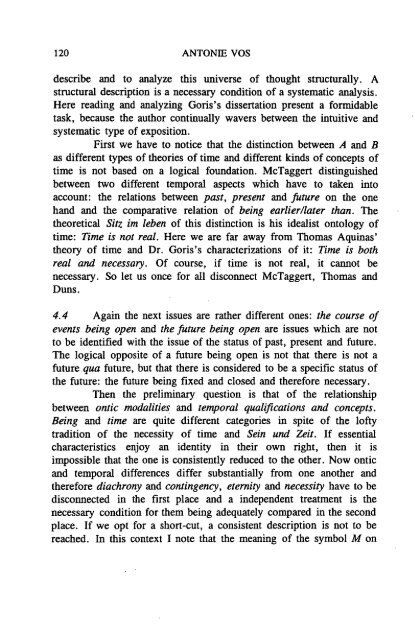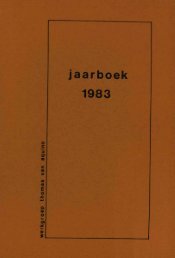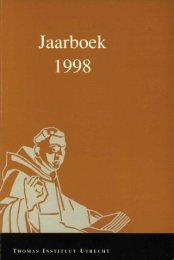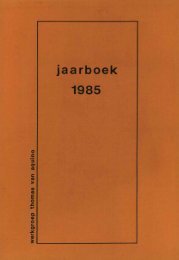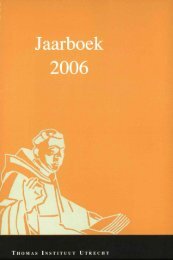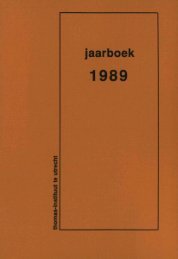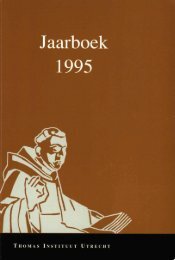Jaarboek Thomas Instituut 1997 - Thomas Instituut te Utrecht
Jaarboek Thomas Instituut 1997 - Thomas Instituut te Utrecht
Jaarboek Thomas Instituut 1997 - Thomas Instituut te Utrecht
You also want an ePaper? Increase the reach of your titles
YUMPU automatically turns print PDFs into web optimized ePapers that Google loves.
120 ANTONIE VOS<br />
describe and to analyze this universe of thought structurally. A<br />
structural description is a necessary condition of a sys<strong>te</strong>matic analysis.<br />
Here reading and analyzing Goris's dissertation present a formidable<br />
task, because the author continually wavers between the intuitive and<br />
sys<strong>te</strong>matic type of exposition.<br />
First we have to notice that the distinction between A and B<br />
as different types of theories of time and different kinds of concepts of<br />
time is not based on a logical foundation. McTaggert distinguished<br />
between two different <strong>te</strong>mporal aspects which have to taken into<br />
account: the relations between past, present and juture on the one<br />
hand and the comparative relation of being earlier/la<strong>te</strong>r than. The<br />
theoretical Sitz im leben of this distinction is his idealist ontology of<br />
time: Time is not real. Here we are far away from <strong>Thomas</strong> Aquinas'<br />
theory of time and Dr. Goris's charac<strong>te</strong>rizations of it: Time is both<br />
real and necessary. Of course, if time is not real, it cannot be<br />
necessary. So let us once for all disconnect McTaggert, <strong>Thomas</strong> and<br />
Duns.<br />
4.4 Again the next issues are rather different ones: the course of<br />
events being open and the juture being open are issues which are not<br />
to be identified with the issue of the status of past, present and future.<br />
The logical opposi<strong>te</strong> of a future being open is not that there is not a<br />
future qua future, but that there is considered to be a specific status of<br />
the future: the future being fixed and closed and therefore necessary.<br />
Then the preliminary question is that of the relationship<br />
between ontic modalities and <strong>te</strong>mporal qualifications and concepts.<br />
Being and time are qui<strong>te</strong> different ca<strong>te</strong>gories in spi<strong>te</strong> of the lofty<br />
tradition of the necessity of time and Sein und Zeit. If essential<br />
charac<strong>te</strong>ristics enjoy an identity in their own right, then it is<br />
impossible that the one is consis<strong>te</strong>ntly reduced to the other. Now ontic<br />
and <strong>te</strong>mporal differences differ substantially from one another and<br />
therefore diachrony and contingency, e<strong>te</strong>rnity and necessity have to be<br />
disconnec<strong>te</strong>d in the first place and a independent treatment is the<br />
necessary condition for them being adequa<strong>te</strong>ly compared in the second<br />
place. If we opt for a short-cut, a consis<strong>te</strong>nt description is not to be<br />
reached. In this con<strong>te</strong>xt I no<strong>te</strong> that the meaning of the symbol M on


